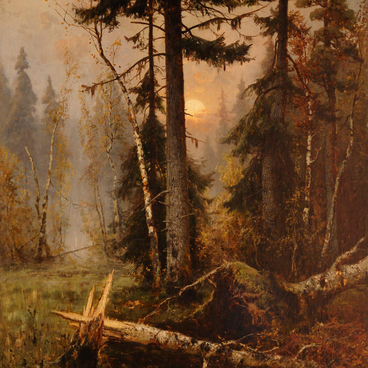Mikhail Zoshchenko painted the picture Letter from the Breadwinner for an art show of the Society for Travelling Art Exhibitions in 1893. In those years, ideas of the Populism movement had a wide public appeal, as progressive intelligentsia wanted to understand common folk, to remember and to reacquire its own ‘roots.’ The Itinerants, members of the society, who found inspiration in Populism, paid special attention to domestic scenes of peasants’ life.
Zoshchenko also found Populist ideals close to his heart. Therefore, he did his best to depict peasants’ life faithfully, with all its hardships and privations — the way it had not been seen or imagined before by residents of large cities.
The main characters of the painting are an elderly couple that saw their regular and quiet life disrupted by a letter. Zoshchenko does not signal in the title what the ‘breadwinner’ is writing to his old folks at home about, but he skillfully renders their facial expressions: The woman cannot conceal her grief and despair, and tears well up in her husband’s bright blue eyes. On the contrary, the deacon who is reading the letter to the family is calm and indifferent, as though he had been accustomed to giving bad news for a long time. His frightfully apathetic face and the dark background in which the characters seem to be sinking emphasizes the horror of the situation in which the peasants found themselves after something had happened to their “breadwinner.”
The dramatic picture produced a strong impression on the exhibition patrons; however, in real life, the story captured by Zoshchenko was quite a frequent occurrence. Many peasants went to town in search of a living, and often worked at enterprises where safety rules or work schedules were not observed at the time, and workers were not insured. Time and again, they got injured, remained crippled for life, or even were killed in accidents. News about those incidents and fatalities came to their relatives in letters.
Mikhail Zoshchenko was born in Poltava, in a family of not very wealthy nobles. When he graduated from a non-classical secondary school, he began to paint pictures based on various subjects from popular life. Zoshchenko’s many works became famous — for instance, the 1888 Rural Court and the 1890 Waiting for Employment.
The artist had eight children, and to keep his family, Zoshchenko started to take commercial commissions, to illustrate magazines, and to design interiors of museums. His son, the famous writer Mikhail Zoshchenko, continued to advocate his views, as he covered the ‘little man’ theme in many of his writings.
Zoshchenko also found Populist ideals close to his heart. Therefore, he did his best to depict peasants’ life faithfully, with all its hardships and privations — the way it had not been seen or imagined before by residents of large cities.
The main characters of the painting are an elderly couple that saw their regular and quiet life disrupted by a letter. Zoshchenko does not signal in the title what the ‘breadwinner’ is writing to his old folks at home about, but he skillfully renders their facial expressions: The woman cannot conceal her grief and despair, and tears well up in her husband’s bright blue eyes. On the contrary, the deacon who is reading the letter to the family is calm and indifferent, as though he had been accustomed to giving bad news for a long time. His frightfully apathetic face and the dark background in which the characters seem to be sinking emphasizes the horror of the situation in which the peasants found themselves after something had happened to their “breadwinner.”
The dramatic picture produced a strong impression on the exhibition patrons; however, in real life, the story captured by Zoshchenko was quite a frequent occurrence. Many peasants went to town in search of a living, and often worked at enterprises where safety rules or work schedules were not observed at the time, and workers were not insured. Time and again, they got injured, remained crippled for life, or even were killed in accidents. News about those incidents and fatalities came to their relatives in letters.
Mikhail Zoshchenko was born in Poltava, in a family of not very wealthy nobles. When he graduated from a non-classical secondary school, he began to paint pictures based on various subjects from popular life. Zoshchenko’s many works became famous — for instance, the 1888 Rural Court and the 1890 Waiting for Employment.
The artist had eight children, and to keep his family, Zoshchenko started to take commercial commissions, to illustrate magazines, and to design interiors of museums. His son, the famous writer Mikhail Zoshchenko, continued to advocate his views, as he covered the ‘little man’ theme in many of his writings.



